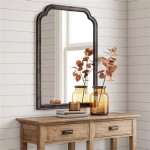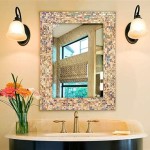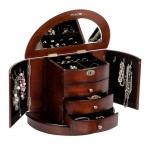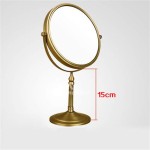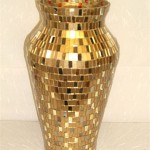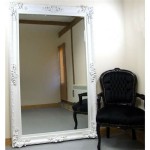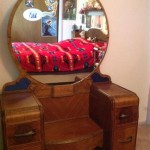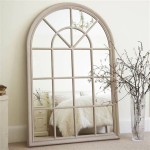Can You Put a New Frame on a Mirror?
Replacing an existing mirror frame can dramatically update a room's aesthetic without the expense of replacing the entire mirror. In most cases, reframing a mirror is a feasible DIY project. However, careful consideration of the mirror's dimensions, weight, and construction is crucial before undertaking this task.
Key Considerations Before Reframing
Several factors determine the feasibility and approach for reframing a mirror:
- Mirror Thickness and Weight: Thicker and heavier mirrors require sturdier frames and potentially additional support mechanisms.
- Existing Frame Construction: Removing an existing frame can be straightforward or complex depending on how it's attached.
- New Frame Design: The intended frame material and design affect the installation process.
- Available Tools and Skill Level: Reframing requires basic tools and some DIY experience for optimal results.
Assessing the Mirror
Before purchasing a new frame, carefully measure the mirror's dimensions. Accuracy is vital for proper fit. Inspect the mirror's edges for any chips or damage, which might necessitate professional repair before reframing. Determine the mirror's weight to ensure the new frame can adequately support it.
Removing the Existing Frame
The process of removing the old frame varies depending on its construction. Some frames are simply glued to the mirror surface, while others are secured with clips or screws.
Methods for Removing Different Frame Types:
Different frame types require different removal strategies:
- Glued Frames: A thin putty knife or wire can be used to carefully separate the frame from the mirror. Applying heat with a hairdryer can soften the adhesive, making removal easier.
- Clipped Frames: Locate the clips holding the frame to the mirror backing. These can often be released with a screwdriver or other prying tool.
- Screwed Frames: Remove screws securing the frame, typically located on the back.
Exercise caution during removal to avoid damaging the mirror. If the frame is particularly stubborn, consulting a professional framer is recommended.
Choosing the New Frame
Selecting the right frame depends on several factors:
- Aesthetic Preferences: Consider the room's decor and desired style.
- Frame Material: Wood, metal, and composite materials offer varying levels of durability and aesthetic appeal.
- Frame Depth and Width: Ensure the frame's dimensions are suitable for the mirror's thickness and overall size.
- Weight Capacity: Verify the frame can support the mirror's weight.
Specialty mirror-framing clips and adhesive can help secure the mirror within the new frame. These are available at most framing and craft supply stores.
Preparing the Mirror for the New Frame
Once the old frame is removed, clean the mirror's edges, removing any residual adhesive or debris. This ensures a smooth and secure fit within the new frame. Inspect the mirror's backing for damage and repair if necessary. A stable backing is crucial for proper frame attachment.
Installing the New Frame
The installation process varies based on the new frame’s design:
- Frames with Clips: Position the mirror carefully within the frame and secure it using the provided clips. Ensure the clips are evenly spaced for balanced support.
- Frames with Adhesive: Apply a strong adhesive specifically designed for mirrors to the frame's inner edges or backing. Carefully position the mirror and press firmly to secure.
- Custom Frames: For more complex frame designs or heavy mirrors, consulting a professional framer is advisable.
Safety Precautions
Throughout the reframing process, prioritize safety.
- Wear gloves to protect hands from sharp edges and adhesive.
- Work on a stable, protected surface to prevent mirror damage.
- Dispose of broken glass or sharp materials properly.
- When dealing with heavy mirrors, enlist assistance to avoid injury.
Proper preparation and careful execution are essential for successful mirror reframing. By understanding the process and considering relevant factors, individuals can effectively update their mirrors and enhance their home decor.
Seeking Professional Assistance
While reframing is often achievable as a DIY project, some situations warrant professional assistance:
- Large or unusually shaped mirrors.
- Antique or delicate mirrors requiring specialized handling
- Complex frame designs or installations.
- Lack of necessary tools or experience.
A professional framer possesses the expertise and equipment to handle challenging reframing projects, ensuring a safe and optimal outcome. They can also advise on frame selection and provide customized solutions.

Diy Bathroom Mirror Frame For Under 10 O Hayley Blog

How To Frame A Mirror For Dramatic Upscale Look

Upcycling That Old Mirror And Frame Into A New One

Dress Up An Old Mirror With A New Frame

Diy Mirror Frame The Idea Room

Painting A Mirror Frame Easy Yet Stunning Ideas Girl In The Garage

How To Build A Diy Frame Hang Over Bathroom Mirror Love Our Real Life

Diy Mirror Frame With My Rocky Mountain Bliss

How To Build A Diy Frame Hang Over Bathroom Mirror Love Our Real Life

Bathroom Mirror Frame Shanty 2 Chic

